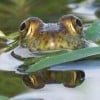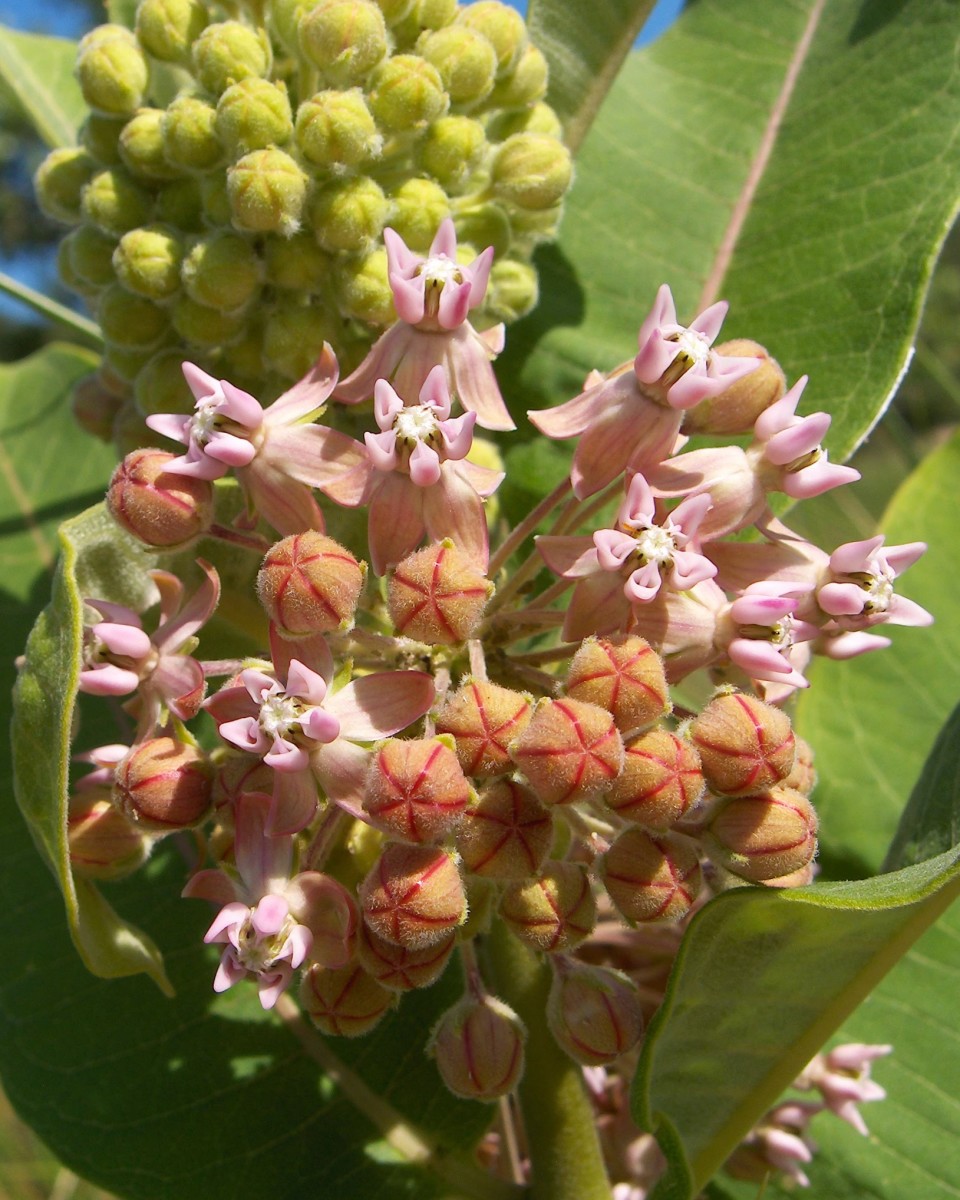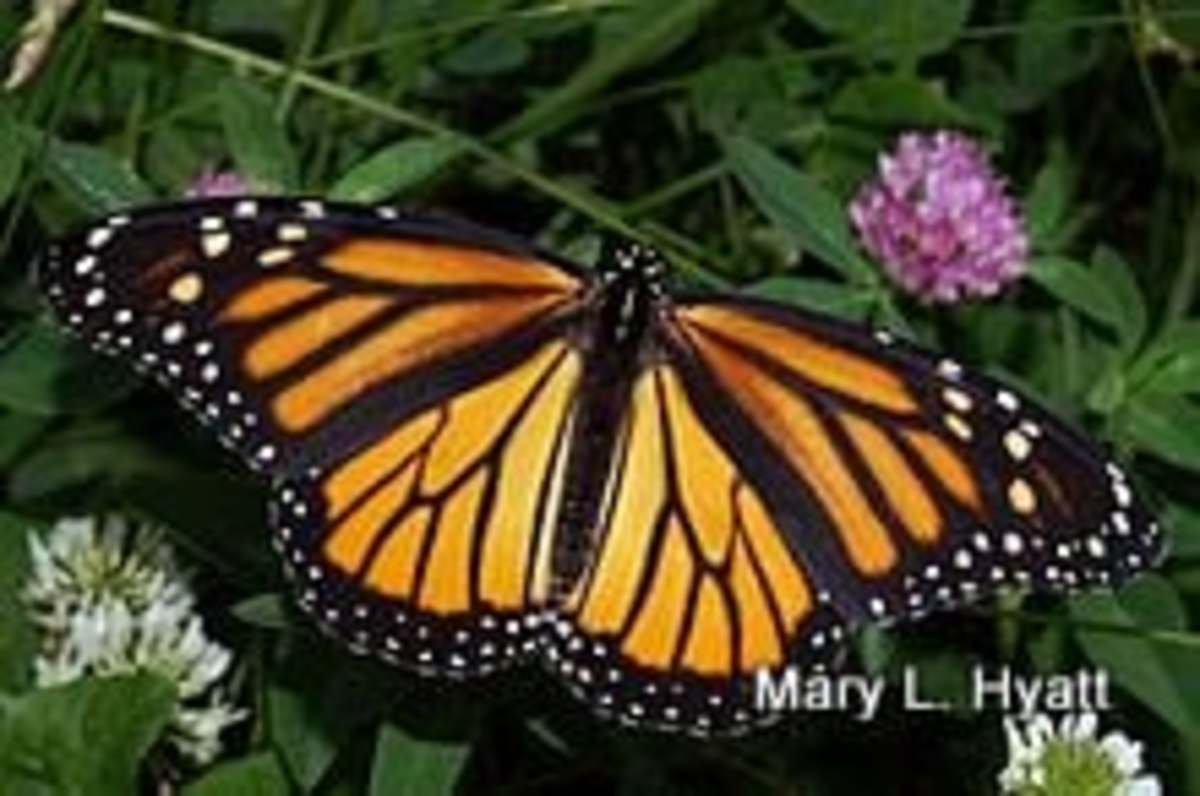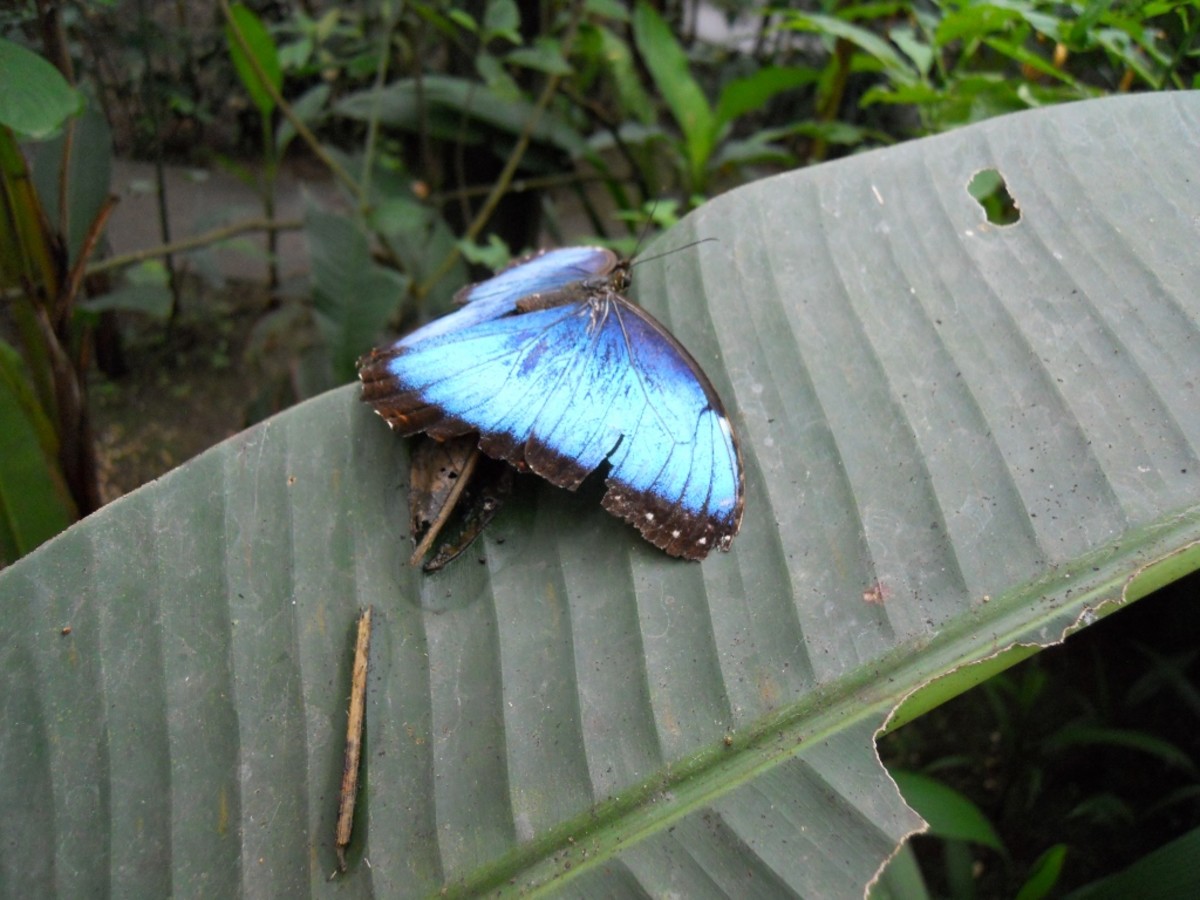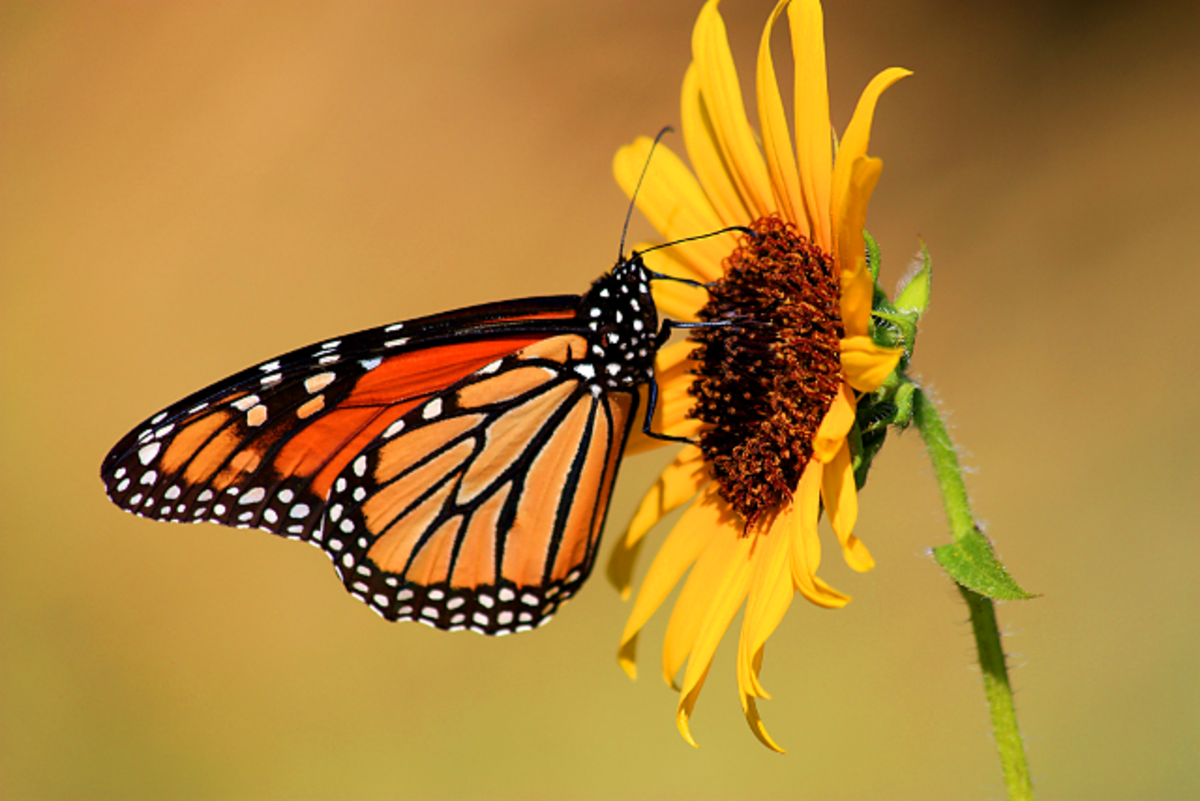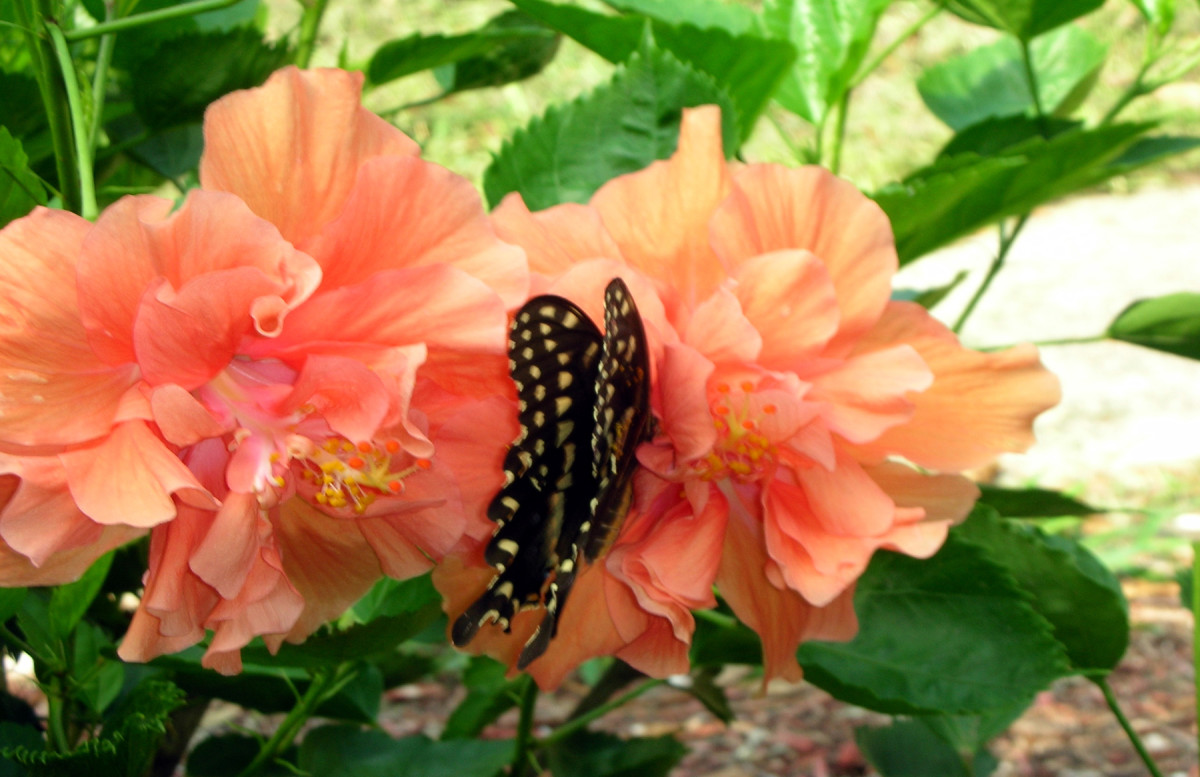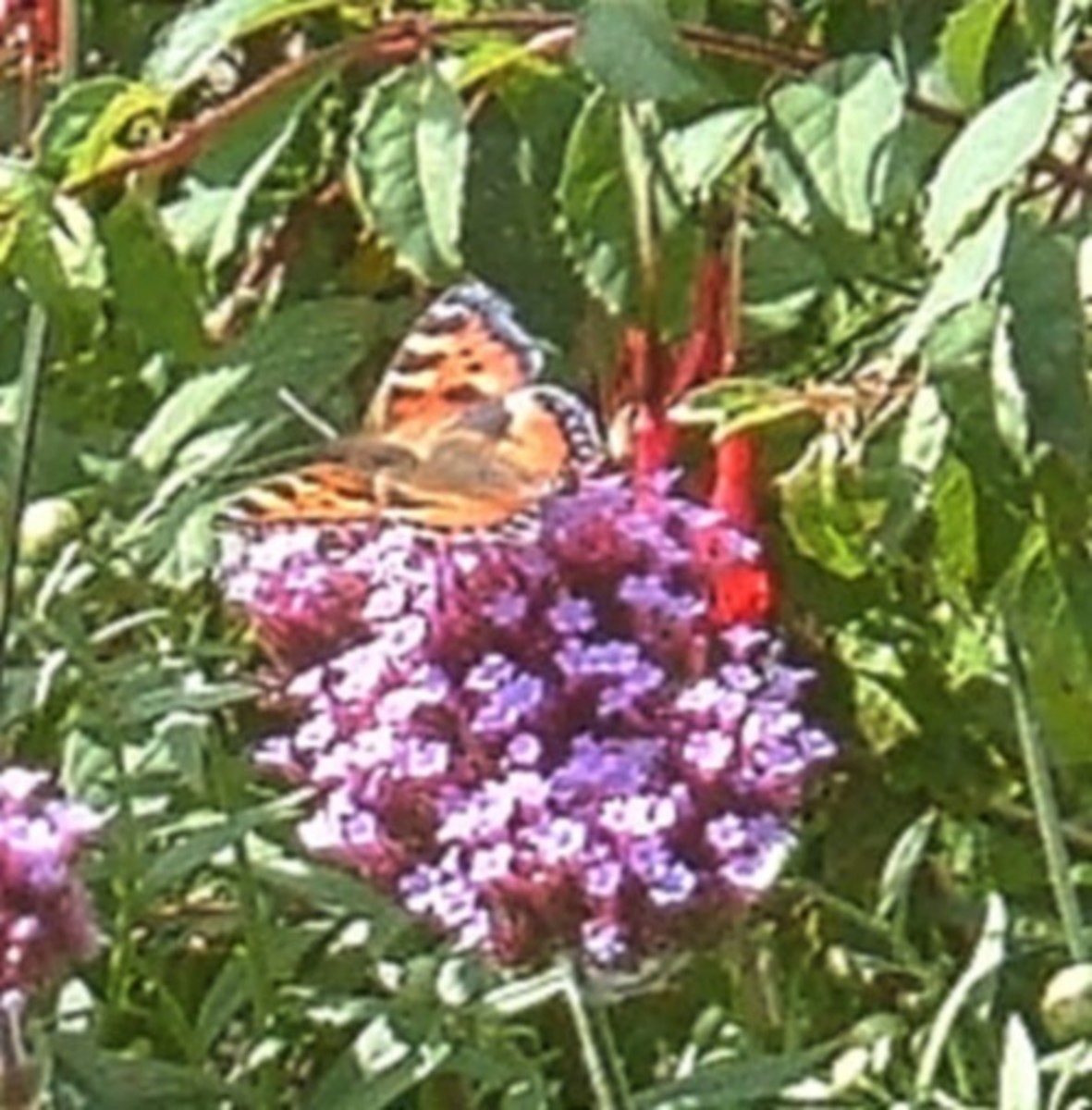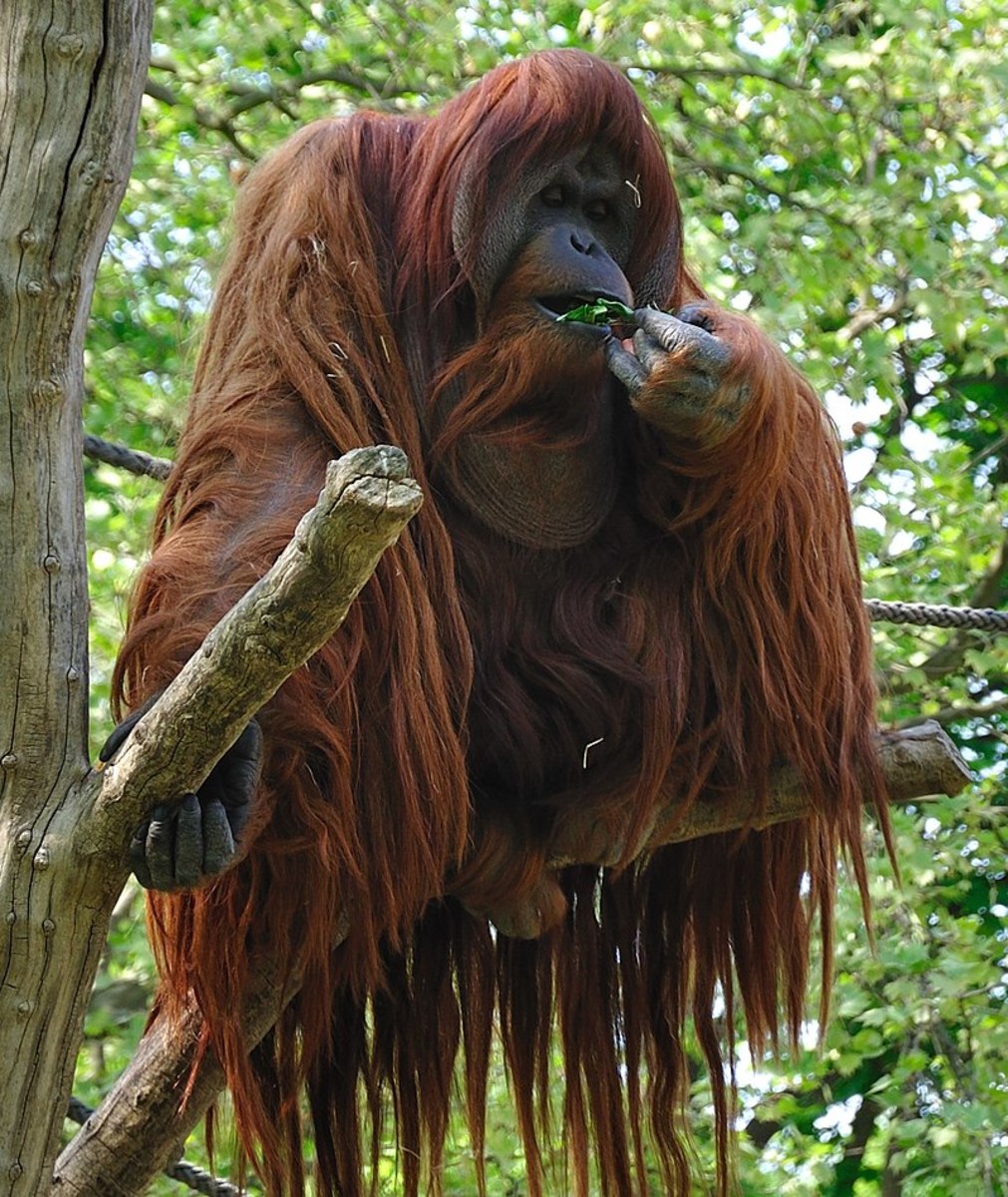The Jerusalem Monarch Butterfly Celebration 2010
The bright distinctive Monarch
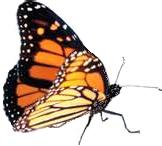
The third annual Monarch Butterfly Migration Festival was held in Jerusalem Community Park on October 2, 2010. Just south of Oklahoma City/Norman, we exited I-35 to travel briefly west to the avid celebration.
It was a clear, beautifully warm Saturday and
driving on state highway 74B we saw several different types of butterflies,
including the striated orange and black Monarch. We followed butterfly
signs along the smooth rural highway, enjoying seeing the new country we had
not discovered previously. (In the hub of the Cole Butterfly Festival of last year, we went what turned out to be a very rural way and ended up in a cornfield with cows, mud and a tractor. But we magnificently arrived after talking with the cows and took lots of pictures there too. )
Western view of the lovely grounds at Jerusalem Community Park
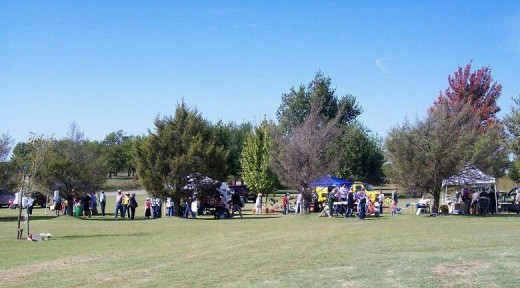
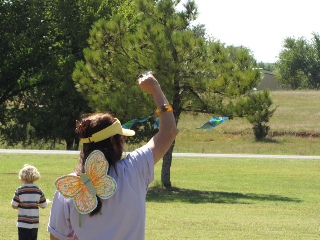
Click to enlarge most pictures.
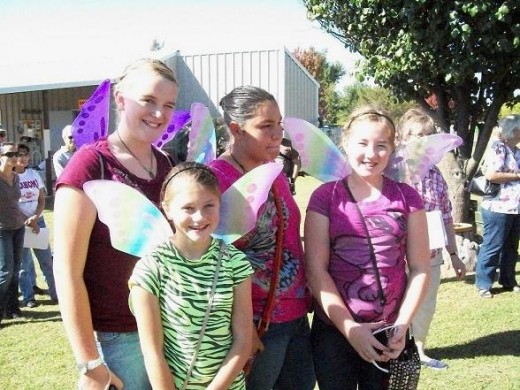
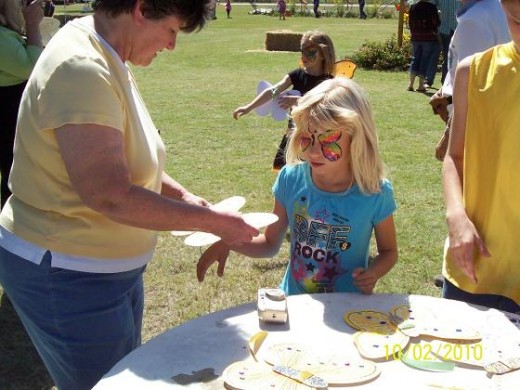
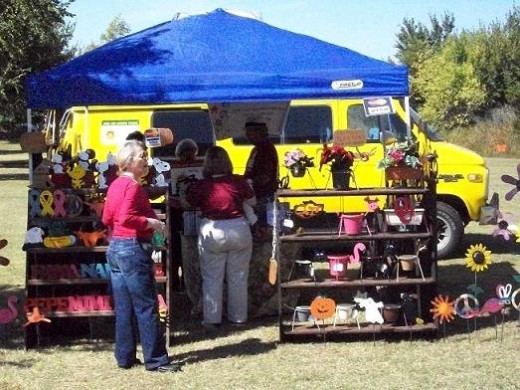
The Jerusalem Community Center is located just two miles east of Cole, Oklahoma*, and is just about three miles west of I-35 south of Norman, taking the Goldsby exit toward the Festival via state highway 74.
The manicured grassy field and bright butterfly garden areas were lined with vendor tents and dotted with people strolling around in the mid-morning sunshine. A gorgeous variety and size of human butterflies in pastel or vivid colors of filmy, delicate winged costumes skimmed around the gardens and lawn areas. No wind blew them. For Oklahoma, no wind is something to be celebrated, and made such a beautiful day for butterflies to exercise. (*Cole was the beautifully shaded undulating site of the last two annual Monarch Festivals.)
There were many costumed and winged humans strolling around the various exhibits, the butterfly holding tent, and the Community Building with its wafting scents of luscious baking. There were people there from New Jersey who could not believe the warm beauty of this clear Saturday. Most visitors were local, but quite a few I spoke with had driven as far as eighty miles to attend the festival.
Everyone became an admirer of the real - and pretend - butterflies as they admired the still bloom-filled nectar gardens. Several spoke of their determination to build their own personal butterfly garden. Conveniently, those type seeds were available for sale and instructions available for growing the best local varieties of plants to nurture the butterflies.
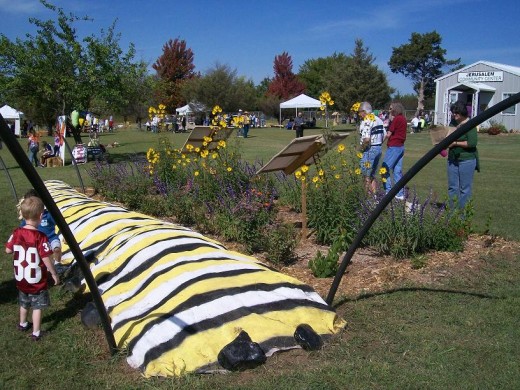
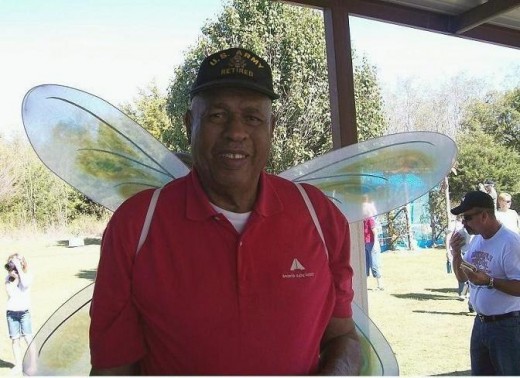
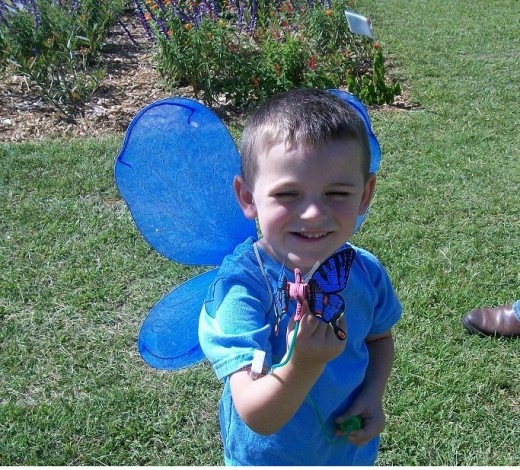
Examples of milkweed and nectar blossoms for larvae and adult.
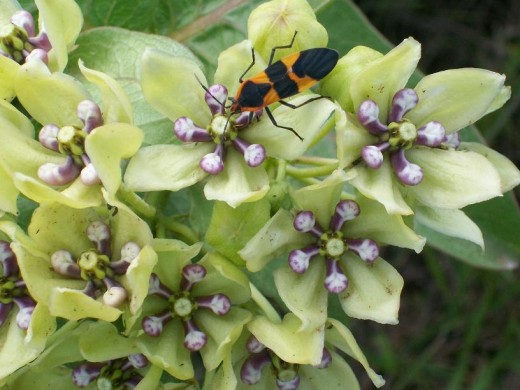
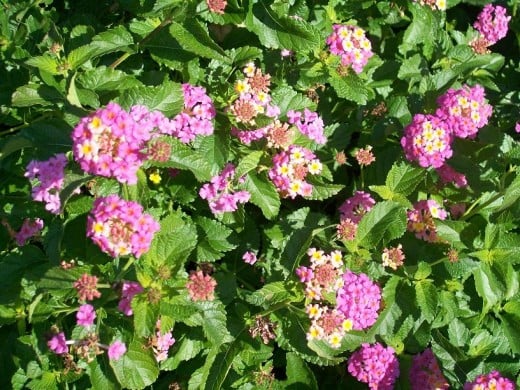
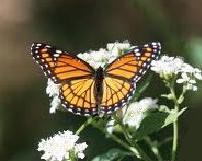
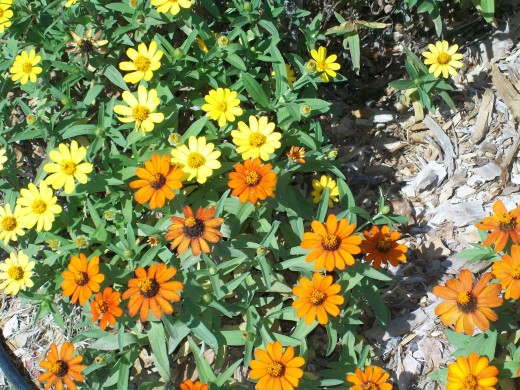
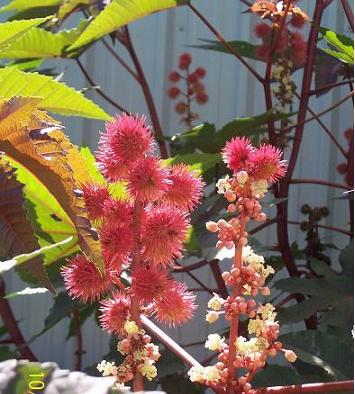
Mr. Joel Bradford, as committed caretaker of this land, had mowed the grassy field and willingly cut fence to allow visitors to park and walk across to the Festival lawn adjacent. That is to be gratefully acknowledged, complimented and was certainly appreciated. He graciously, and genial, posed at my request to photograph him in his beautiful wings. I thought they might be angel’s wings too, upon this dedicated individual.
Mr. Bradford is caretaker of this historic four acres area donated to the Freedmen survivors by the Chickasaw and Choctaw Tribes of Oklahoma before statehood. He is a true native son who owns farmland nearby the now archaic Washington townsite, where the New Jerusalem Community Park is located. The recorded history of this land is that it was “patently deeded” to the local Freedmen, ancestors of many of the present population, to be used for its intended purpose of affording their progeny the land for community facilities available in perpetuity. Should the inheritors decide to forego the agreement the land would revert back to the Indian Tribes.
The festivities have further purpose too.
.
The underlying purpose for this Monarch celebration is a sober one; an intention to preserve habitat and nurturing host plants for the majestic Monarch. Much of their natural sustenance territory is being increasingly destroyed by use of herbicides and additionally destructive pesticides. Inundation of their indigenous home sites by civilized encroachment, similar deficiency of migratory feeding sites, has led to the Monarch lifecycle being fraught with an overcapacity of survival problems.
The Monarch’s larval host plants are only milkweeds, of which there about fifteen species in Oklahoma. The milkweeds are being literally decimated by the use of chemicals/herbicides, and thus cannot regenerate to afford food for the caterpillars. This is a major problem in the United States and continues into Mexico. However the Monarch wintering forests of Mexico are also disappearing both because of logging, chemical usage and civilized intrusion.
The Monarch is the only butterfly to migrate yearly, two long trips a year for those that do not die either going south or returning north, some flying as far as Canada. The summer feeding grounds and the distant wintering sites must be preserved, or this insect will cease to survive. And the multiple routes of migration across North America must provide food for them to arrive at their destinations
Annie Hart and her dedicated volunteers are determined to play a part in easing this stress, not only by celebrating the beautiful winged insect, but in educating and encouraging interested persons in the process of building host/nurture gardens for the Monarchs. The annual Festivals are a pleasurable experience: But the foundational purpose of preserving milkweed habitat will also support this tiny struggling specie and bring satisfactory fulfillment to those involved in a quality cause of assisting a hapless beautiful creature.
An interesting side note about
milkweed is that its sap has a natural repellent in it that helps protect the
caterpillar from attack via birds, other predators. But mice, a certain type of oriole and a grosbeak can still eat the Monarch and not get sick. The similar appearing Viceroy, pictured above on white milkweed, greatly mimics the look of a
Monarch so it doesn't get eaten as much, via its copycat looks.
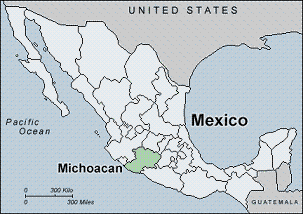
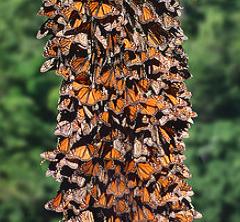
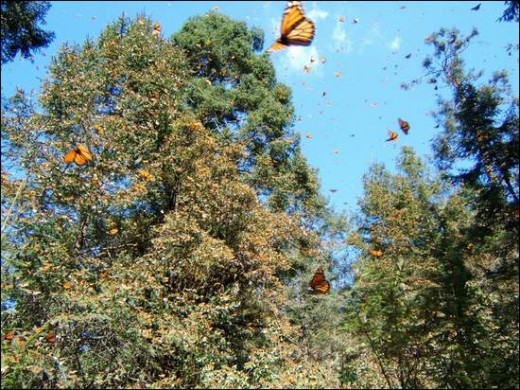
Mexican natives have known of the Monarch Migration annual occurrence for possibly centuries.
One of the foremost wintering sites for multiple millions of Monarchs is Michoacan, Mexico. It is factual legend that when the clouds of fluttering orange and black creatures gathered yearly on forest areas there, the native peoples celebrated it as ‘the Festival of the Dead’, because they believed it was their ancestors revisiting them.
There have been write-ups of the discovery
and research regarding this extraordinary yearly occurrence in magazines such
as the National Geographic, Arizona Highways and other nature-based magazines. A few years back PBS television programming
shared a chronicle of this magnificent discovery – one that was amazingly
recent considering our technological and scientific abilities. We know today that the ‘visitation’ is an
immense bio-scientific occurrence and the study of the Monarch migration routes,
habitat and survival requirements is ongoing. (Anyone may join in this research with small effort and as little or much involvement as desired. Links to explore this possibility are at the end of this article.)
On a modern day scale, literally at this year’s Jerusalem Monarch
Festival, such a tenderly similar story to this legend was brought to mind by the following incident...
Leah is a young lady who volunteered to be a parking assistant for the Jerusalem Monarch Festival.
While she was directing cars to parking areas, an older man drove up and remarked “I shouldn’t be here”. Perceptively, Leah asked him why he said that and he replied, “My wife wanted to come to the first Festival and we didn’t come. Then she wanted to come to the second Festival and we did not attend. Now this is the third one and she has died. I just can’t stay.” The gentleman then left and about fifteen minutes later, he returned. As Leah again directed him to park, he told her this: While I was driving, a beautiful white butterfly flew inside my car. I just had to come back.”
Later he found Leah and proudly shared with that her he had spent all
nine dollars he had with him, and was so very glad he had decided to attend!
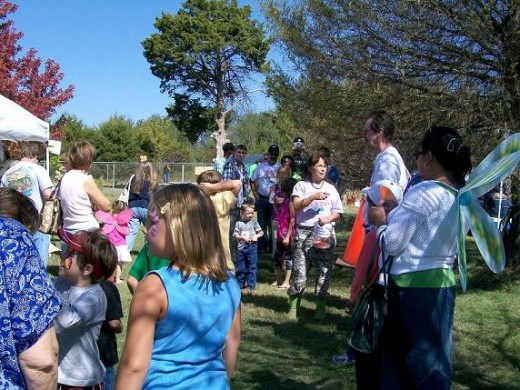
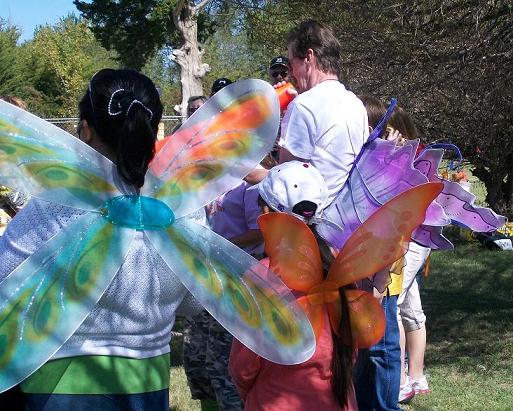
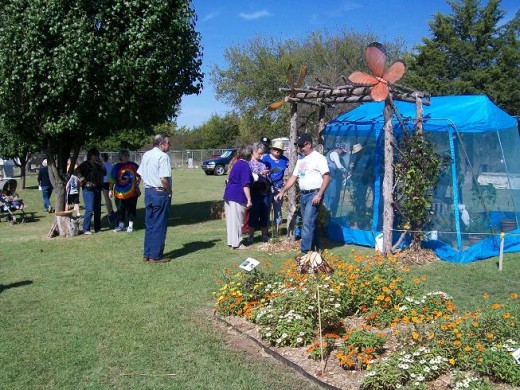
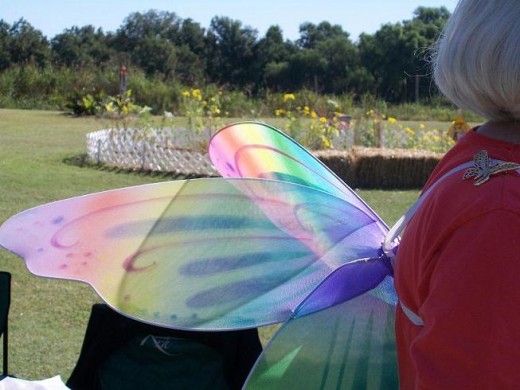
There is more than celebration; assistance and freedom and responsibility play a part in the festivities of the Jerusalem Monarch Migration Celebration.
Mother Milkweed, also known as Annie Hart, strolled round about, busily checking events, answering questions, and being greeted by friends, visitors and volunteers. She is the capable Founder/Director of the yearly Monarch Migration Festival and a busy confident lady, filled with the joy of being able to assist a disadvantaged natural resource --the Monarch butterfly. That indeed is the purpose of the butterfly Festival --to educate others of the need for and to assist in development of host gardens for the comeback of the Monarch.
In 2002 an
exceptional freeze in Mexico killed a large percentage of the over-wintering
Monarchs there. This has been estimated to have been 80% of the Monarch
population which meant hundreds of thousands of them died. Also the decreasing
food supply for the larval caterpillar and
butterfly remains a concern along the migration routes all across North America to and from Mexico. Monarchs lay their eggs on the migratory routes back north and must find suitable habitat to nurture their larvae: Milkweed plants. Period.
Since the Jerusalem/Cole site is a known migration track, the general area needs to be locally abundant in food supply for the traveling butterflies. Some do spend summers in the vicinity and the host plants for caterpillar/chrysalis development are beginning to be multiplied to assist the rebounding population of the Monarch, but more nectar gardens are needed.
(Note: A map of the officially mapped migration
routes in the United
States is
found in the article about the 2009 Cole Butterfly Festival.) The central Oklahoma area from northern border to southern border has been
officially mapped as known migration pathways, though the visible numbers sway up and down with the flow of the migratory
flight variation. Other colorful maps of migratory routes may be found at monarch-butterfly.info/maps.
Monarch tags identify the locality from which they are released. Tagged butterflies are officially recorded when located for tracking their routes.
Annie and her effervescent volunteers not only arrange to help caregivers of the Monarch larvae, chrysalis and butterflies, they have official ‘tagging rights’ of each butterfly released from this local area. The numbered and locally identified tagged butterflies are sought and their routes logged, either along the way or in Mexico, thus facilitating increased information about the vast miles these fragile but determined butterflies must fly each year. It does not hinder the butterfly’s ability to fly to be tagged.
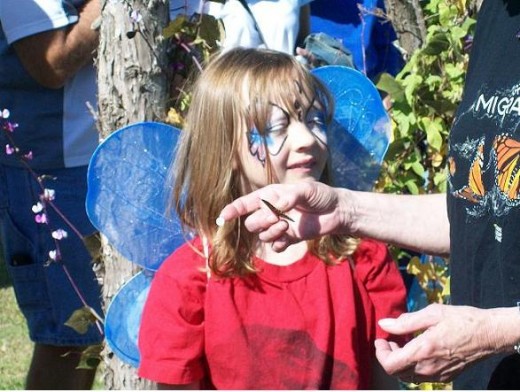
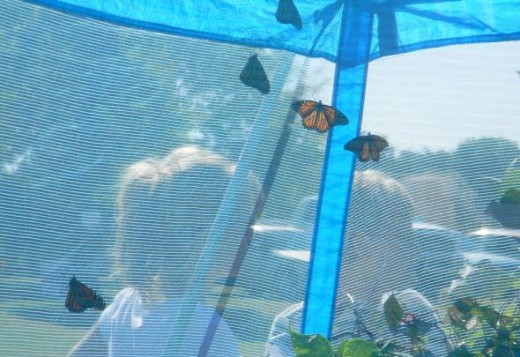
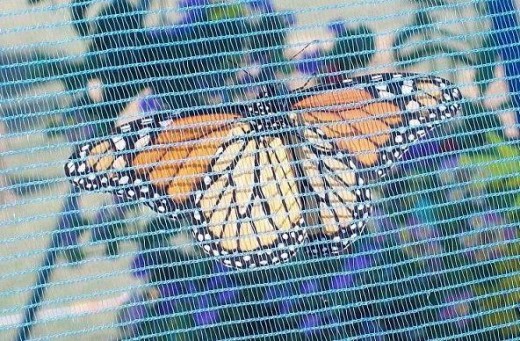
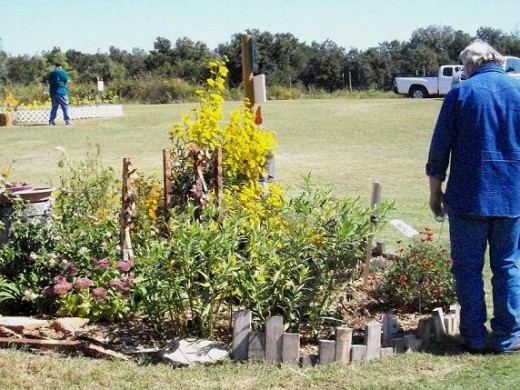
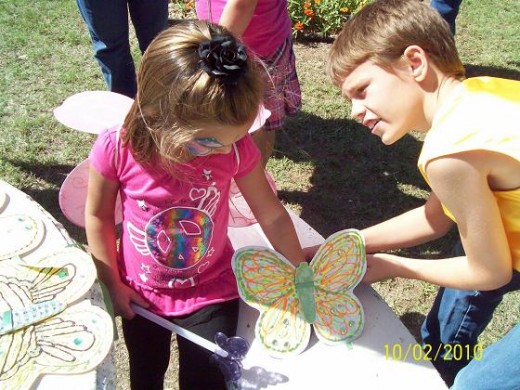
Questions? Lots of answers are available!
The volunteers of the Monarch Migration Festival are offering assistance to any small community in central Oklahoma in educating and advising on formulating local nectar gardens. Thus, the choice was made to have the Festival at Jerusalem Community Center where the new summer gardens had been planted and cared for by local peoples. Of unique delight was the giant caterpillar in front of a main nectar garden. Annie explained that when the garden area was dug out, the hefty mound of dirt was going to have to be hauled away -- another heavy load of work! Then someone came up with the brilliant idea of covering the long soil berm with canvas, painting it like a Monarch caterpillar, fitting it with pipe 'feelers' and large rocks painted black for the eyes! Wonderful and perfect! The caterpillar belonged! It is a pleasing place for the children to climb, pretend, and pose for pictures. And they did. Of course the nectar flowers beside it are bright and inviting for all variety of winged creatures both for food and restfulness, but visual enjoyment for we who do not possess wings
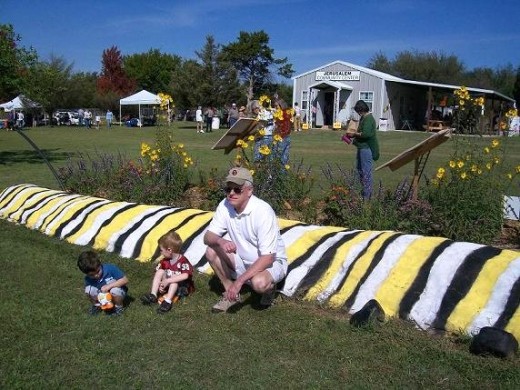
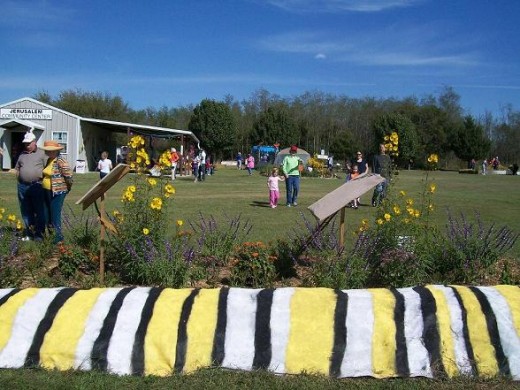
The Blanchard 4-H Club had prepared several exhibits.
Inside the Community building, instructors and leaders of Blanchard 4-H club presided over interesting live exhibits of colorful caterpillars, chrysalises and butterflies their students have nurtured during the year. There are lots of well studied and arranged displays of metamorphosis, of birthing butterflies, feeding and caring of caterpillars and chrysalises. Educational materials on host and nectar seeds and plants are made available and some of the best local type seeds and plants are also yours for a donation
Click to enlarge picture view.
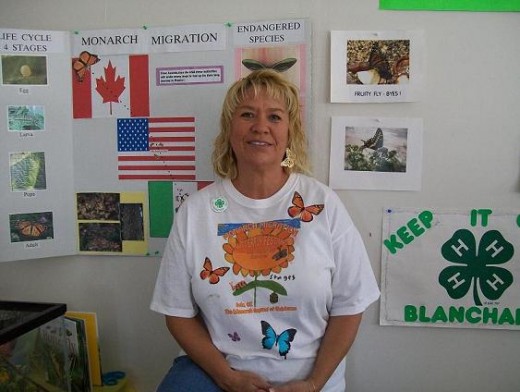
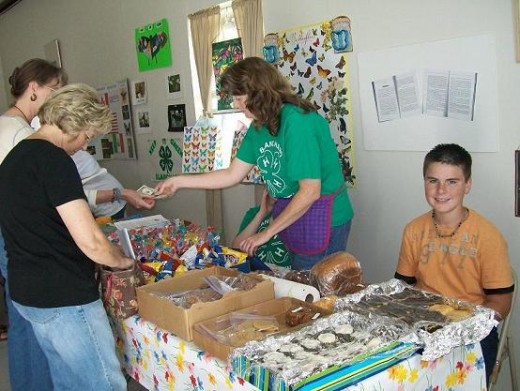
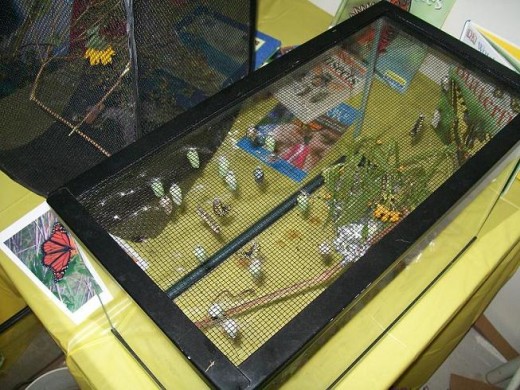
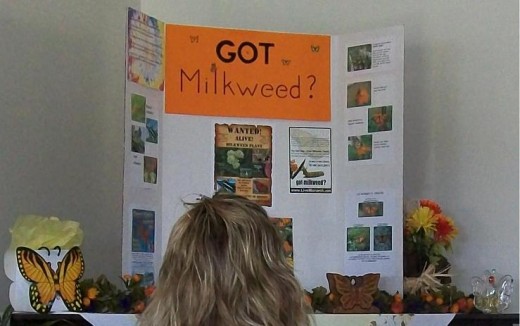
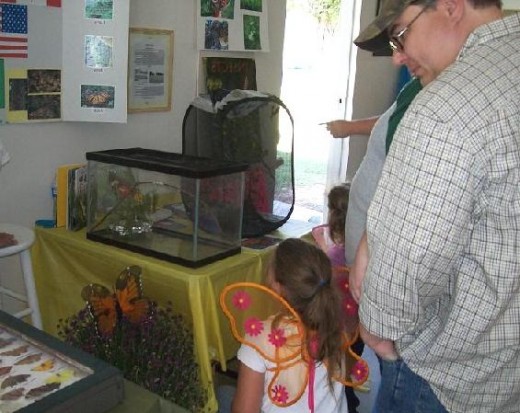
Educational activities with a purpose can help afford the maturing of responsible action.
Nora and Donna, who are leaders of the Blanchard 4-H Club, supervised the displays inside the Community Building and had competent knowledgeable young assistants there to also answer questions and explain their demonstrations. (Also selling yummy peanut, chocolate and other goodies!) There were well-done portrayals of life stages of the butterfly. It was true hands-on education with visual results of excellence. They depict the usefulness of a well directed educational experience and substantiate a realistic exciting learning process through constructive activities.
Their cage for larva had over fifteen pupae and a few newly hatched butterflies, all hanging from the afforded wires, invisibly changing, or revitalizing themselves for their coming trip. Vital for the larval feeding was milkweed of which there are about 15 species in Oklahoma. Butterfly weed and antelope horn are two common plants of this type. Nectar seeds like the zinnia, lantana, sedum, sunflower, salvias, castor bean and others were available as well as printed information on their planting and care.
Additionally, other herbals like dill, fennel and parsley
are prime host plants for the beautiful Black Swallowtail, which is our Oklahoma
state butterfly, a lovely companion to the bright Monarch. The Blanchard 4-H Club had a large glassed display of many butterflies labeled with their descriptions.
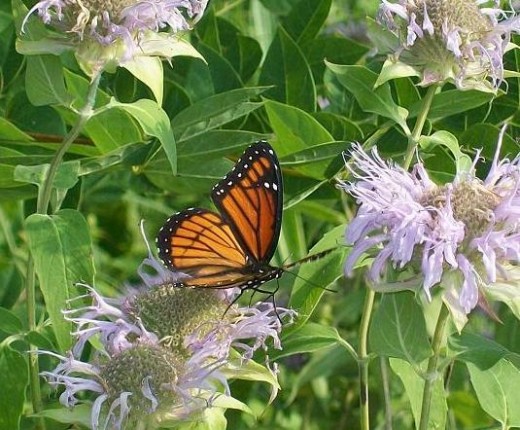
Delicious home-baked foods: Lots of choices!
And of course the Home-Baked Sale was a focal point of busy-ness all day. There were so many different breads, pastries, cookies, muffins, pies, cakes and all were luscious, exuding tempting fragrance of spice and sweet. My favorite again was the nutty carrot cake, but my daughter delegated that honor to the spicy pumpkin bread she purchased. We ate our treats relaxing in the shade near the ‘picture-taking butterfly board’.
Coffee, carrot cake and chocolate brownie...that's NOT the end of it! More muffins, pies, cookies...Yum!
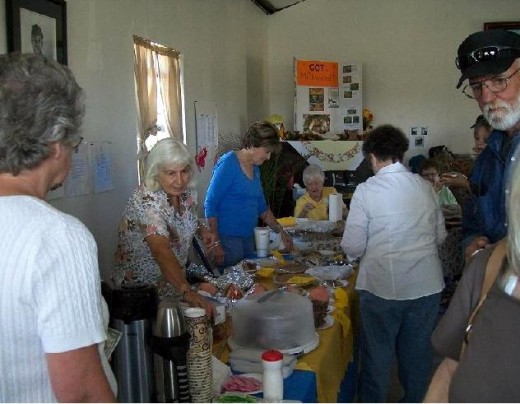
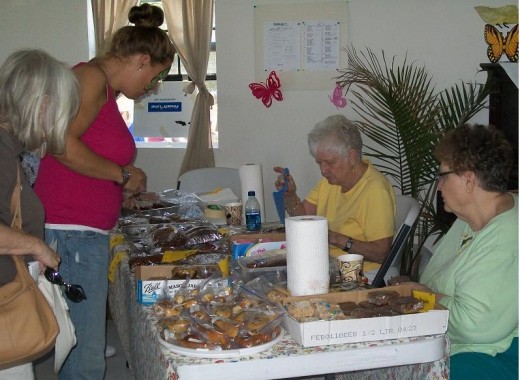
You may click on most pictures to enlarge view.
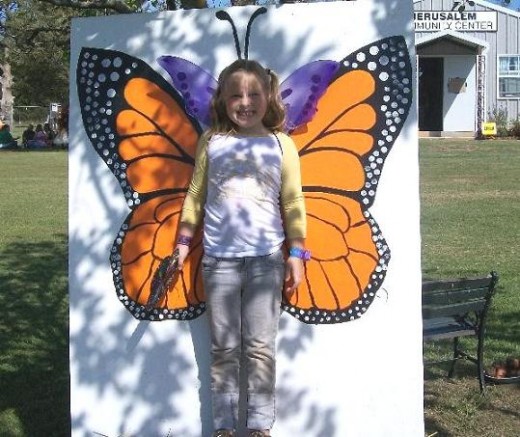
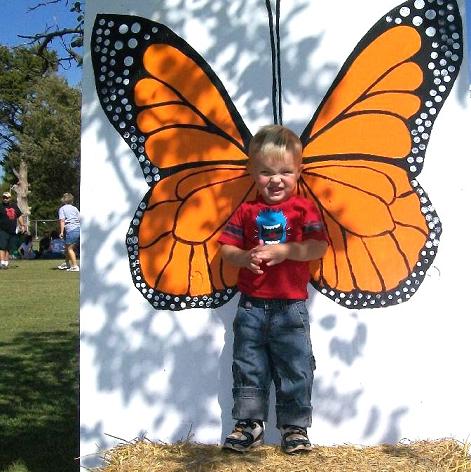
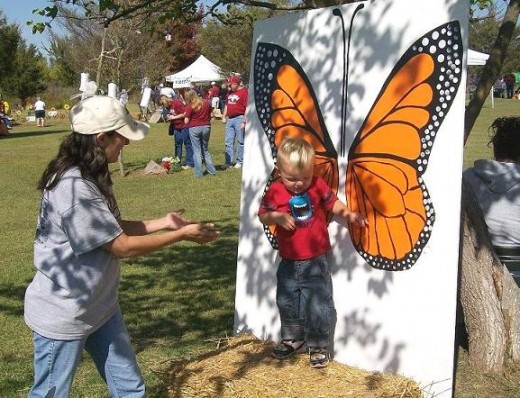
Sister and brother gleefully pose in front of the Monarch.
This giant Monarch picture-background was available for photographers and those who wanted to pose. The large detailed board was set up with a hay bale to stand or sit upon. It was fun to watch each child climb to stand and smile, wave, wiggle, pose, and ‘become the butterfly’ for a few seconds. Oh, the innocent delight of children! And the treasure-taking moms, pops, grandparents; all vied for having the most fun!
This young sister and brother took turns climbing on the hap bale to pose in front of the Monarch for their smiling pictures. Mom got her photos of sister, then little brother finally got his turn. He joyously clowned for the camera, obviously having a grand time. Then when Mom said 'That's all, it's time to go.", he did NOT want to get down. (Note: This picture was also posted on www.ulocal.koco.com where it was favorited with five star votes in the 'Cute Kids' category.)
There were filmy butterfly wings for sale and butterfly headdresses. Also butterfly trinkets and bookmarks, and wands...and yard decorations for any preference whether floral metals or wooden holders, even wind socks. The bottled water tent was kept busy handing over icy dripping bottles that were refreshing to the palate after all that delicious confectionery.
One vendor had plants for butterfly gardens as well as a vast variety of décor to also 'plant' in the gardens: Things like large metal flowers, butterflies, geometric designs coupled with varied pots and other lawn decor.
Vendors of butterfly related wares -- and painters of little faces caught the attention of everyone.
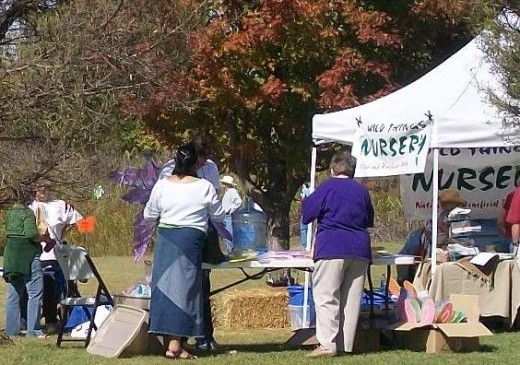

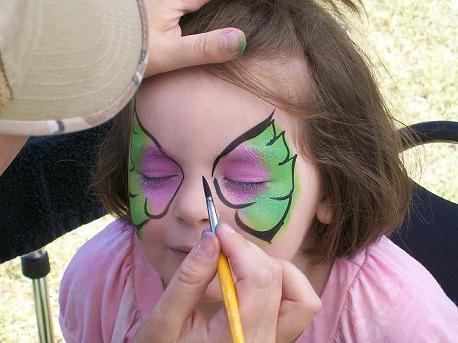
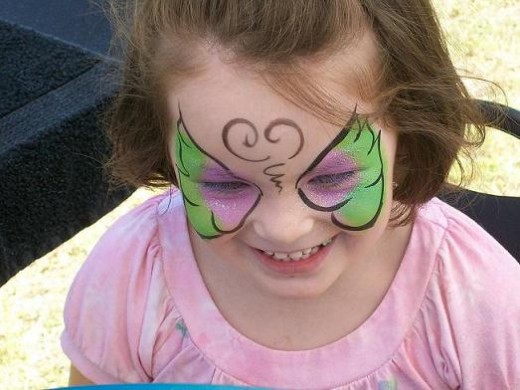
That crammed full butterfly-face-painting-tent was a delight to visit and watch as expectant little faces became butterfly-designed happiness. The talented face-painter was busily fast, excellent, and enjoyed the pleasure of decorating children.
It was interesting and touching fun to watch a
child remain motionless for face-painting and then see their admiring amazement
at a first glimpse in the mirror! Delightful!
So many gorgeous butterfy faces --and delighted hearts!
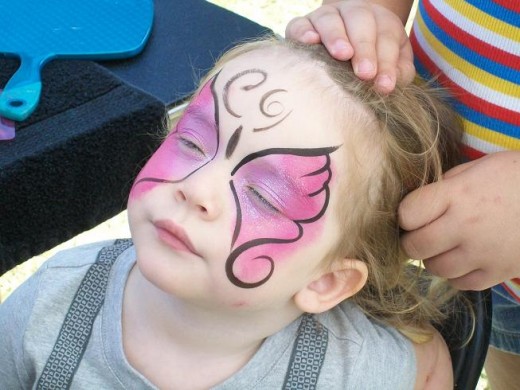

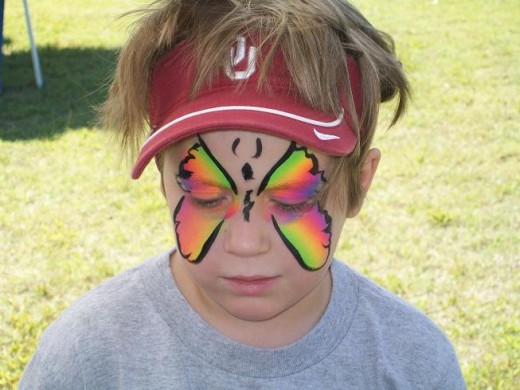
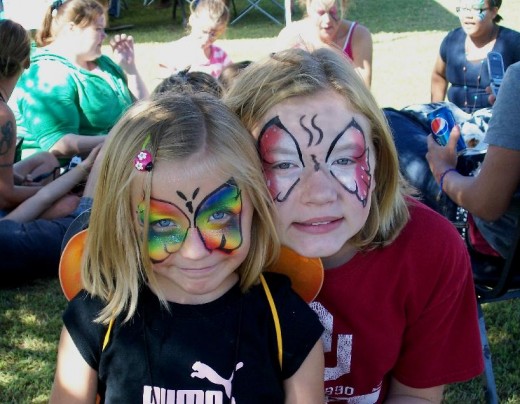
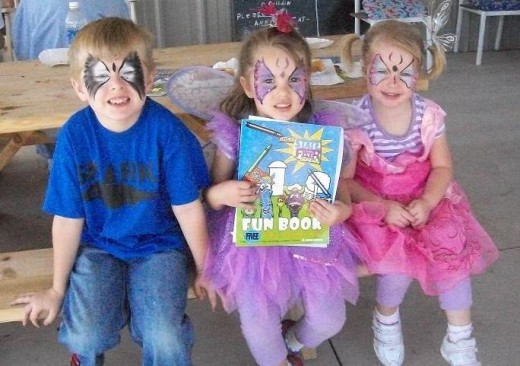
You don't mean to tell me you're still hungry?
Jimmy White, head chef, kept himself and crew busy grilling what must have seemed like jillions of ‘dogs’! His main assistants were his brother Raymond, and Norman; and Margaret McKinney from Blanchard. Thank you guys and gals for your delicious, efficient hard work!
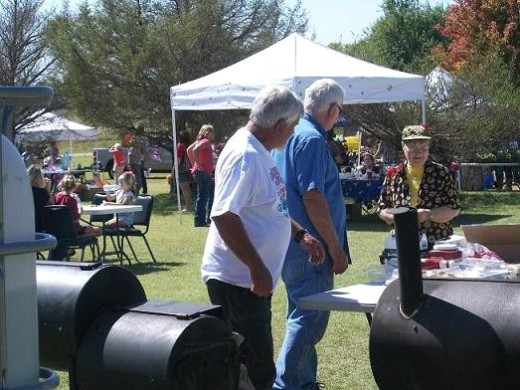
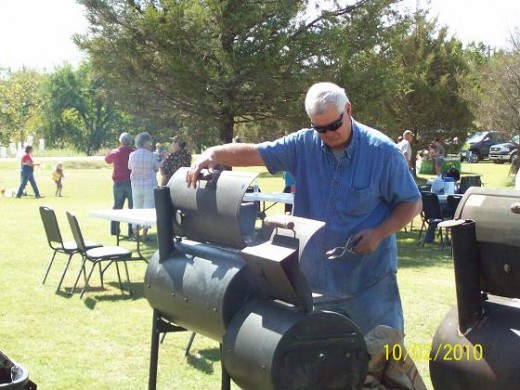
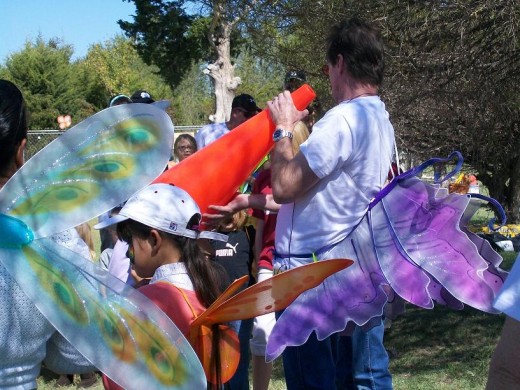
Lunch, and butterflies and helping hands - they were everywhere.
All those helpers who kept huge hotdogs on the grills,
to be piled high with mayo, mustard, ketchup, relish, and extra-long sausages
that spiced the tongue did a jovial and efficient job of keeping the ‘dogs’
coming as people lined up to purchase lunch. It seemed that every
volunteer was courteous and generously friendly to any who would accept a smile
or a lighthearted laugh of 'community'. The camaraderie was contagious -
people and butterflies were all having a wonderful time, each in its own
friendly way; i.e. visiting with each
other, visiting flowers, wafting the light breeze or escaping the excited hands
of friendly children--who maybe had just downed their hotdog!
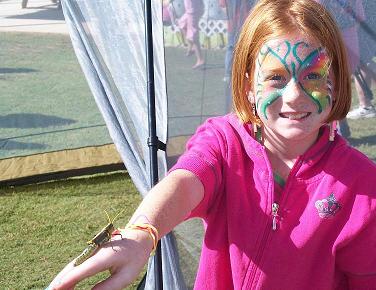
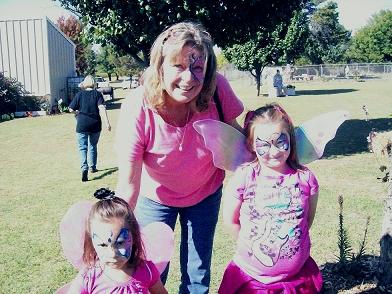
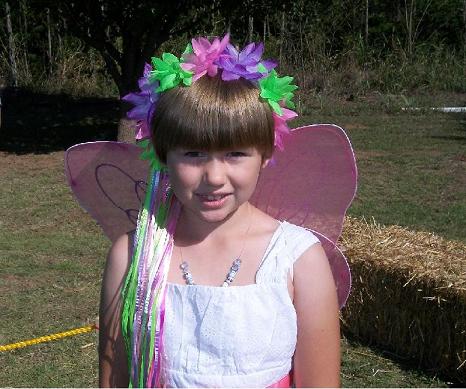
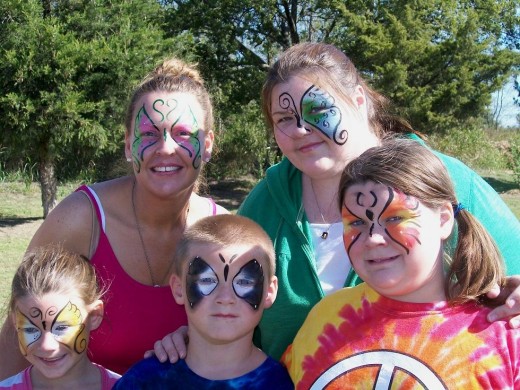
Monarchs were periodically released from the holding tent after being tagged, thus starting their long flight south.
This year tickets could be inexpensively purchased for children to assist releasing a butterfly to begin its journey to Mexico. Previously there were too many clamoring, for all to 'help', so the ticket idea was an ideal solution as to who would have the privilege of starting a Monarch on its long trip. About every thirty minutes or so a name would be drawn from the ticket basket and that lucky child would cautiously assist Linda Schemmer, 'The Butterfly Lady' who would explain how to gently hold the fragile creature and then release to let it begin its journey south. Each time of release the circle of moms and dads, aunties, grandparents and friends would take pictures and "Hooray" as the deed was accomplished. One more winged beauty would begin its instinctive journey of ‘impossible accomplishment’.
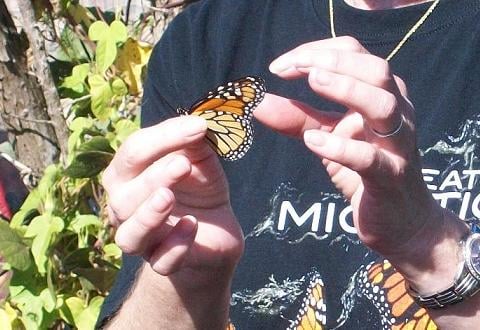
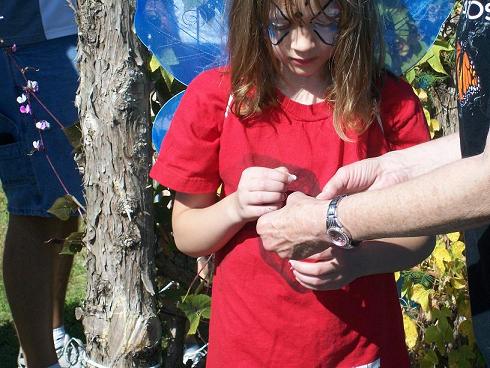
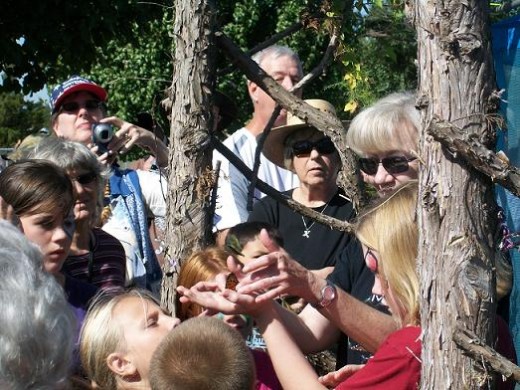
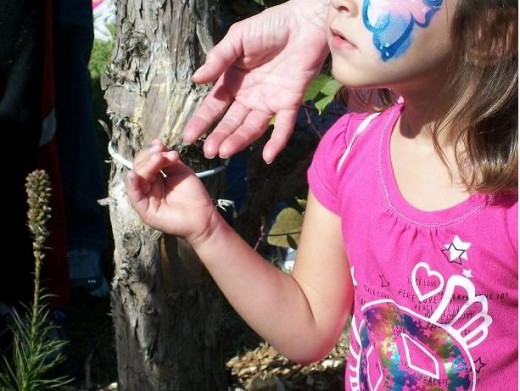
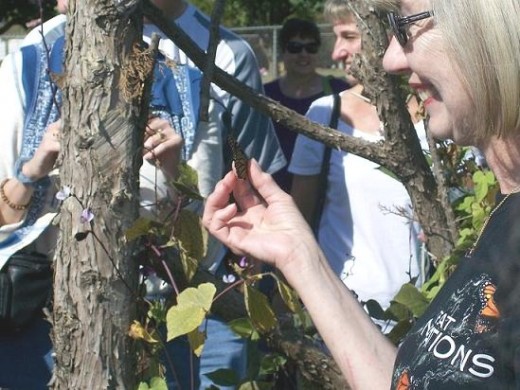
Ongoing research began with a curious biologist from Canada.
A Canadian biologist, Fred Urquhart, began Monarch tagging research in 1952. In the early 1970s the pattern of Mexico/North American migration tracks had emerged. A comparatively few number of Monarchs west of the Continental Divide overwinter in a limited area of southern California, though their number is in the many thousands. Two major sites there are Monterey County and Pismo Beach State Park. The Monarchs east of the Continental Divide travel various routes to Mexico to one or more of the three major known winter sites in the Sierra Chincua mountain range. Angangueo sanctuary location on the lee side of the high peak lies about sixty miles northwest of Mexico City while another known site in Michoacan is about eighty miles west of Angangueo.
These sites are only a few acres of pine and oyamel tree forest and as the Monarchs arrive, trees become covered so heavily the branches are laden with fragile bodies and trunks are totally covered with them. As researchers for National Geographic have photographed and logged their discoveries through the years, they find themselves are places for the clinging-hanging butterflies also.
The sluggishness of cold affects the butterflies but as the day warms, they become more active. As they continue to mature, some mate at the site to lay their eggs on milkweeds as they return north to summer home habitat.
Rodents, as well as an oriole and a grosbeak are the major natural predators to the monarch at the Mexico site as well as on the trip home. (Other birds become ill or die if eating Monarchs, as the milkweed sap contains poisons to cause this and its ingestion as a caterpillar still protects the adult.)
One theory of the Monarch’s ability to migrate unerringly as far as 2500 miles was discovered in the early 1980s. It was found that Monarchs harbor the mineral magnetite in their bodies. This mineral has the ability to align north via the earth’s magnetic field, and some scientists believe this allows a biological compass to guide the butterflies. This could be feasible explanation as many Monarchs make the trip only one unerring time.
Many happy 'butterflied' people strolled the lawns.
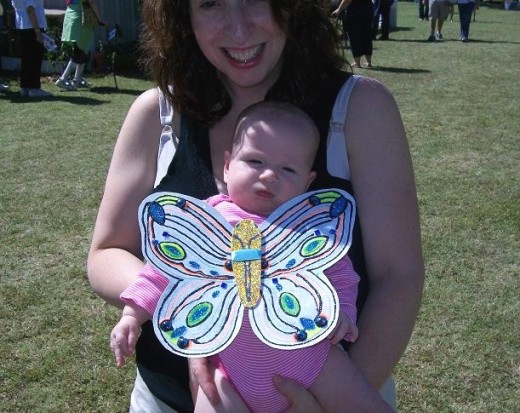

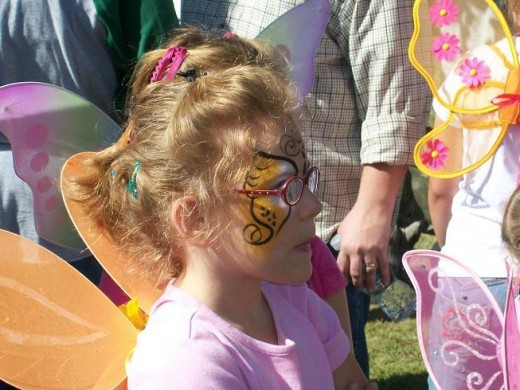
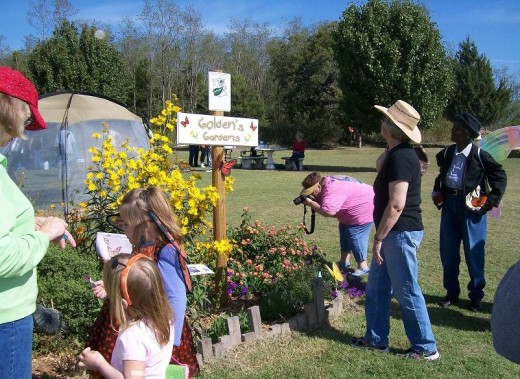
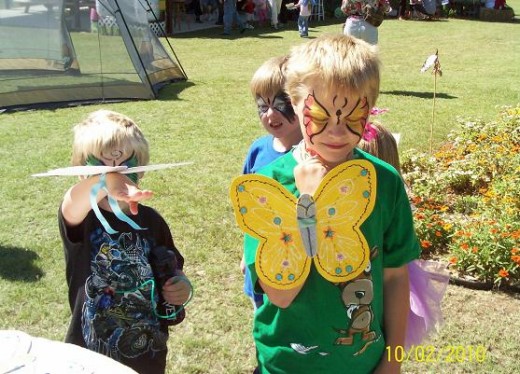
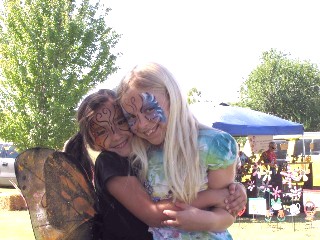
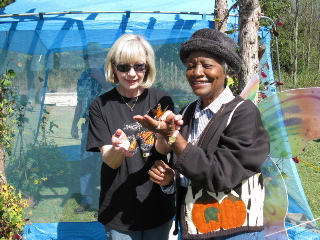
Ah! The Children's Butterfly Parade!
And then there was the jovial costumed Butterfly Parade as a highlight of the afternoon! This year each child was given a large glittering butterfly decoration to tie on a wrist to flit around while marching in the parade. There were so many butterflies, flowers, beautiful costumes, diaphanous wings, each one unique and every one delightful! Every child - and some enticing adults too - was a magnificent display of butterfly delight, whether just wearing wings or donning a full gossamer costume.
With
Annie Hart leading the parade and industriously scattering her milkweed seeds,
the parade wove its way from the north side, west past the vendor tents, around
to the southern front butterfly garden area – and that inviting caterpillar.
There the children sat on their immobile striped friend and posed for lots
of pictures. Surely, many memories were
gathered that day both in mind and in photo, and just as certain, many will be
treasured for lifetimes to come.
4 second video of Monarch being released. It was ready to GO!
Children's Butterfly Parade, Jerusalem Community Park.
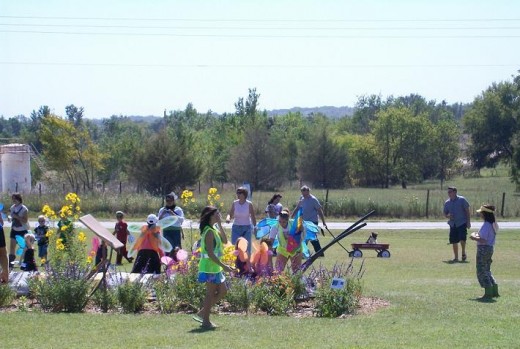
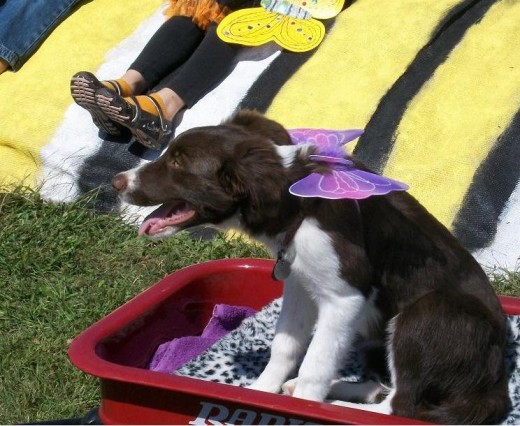
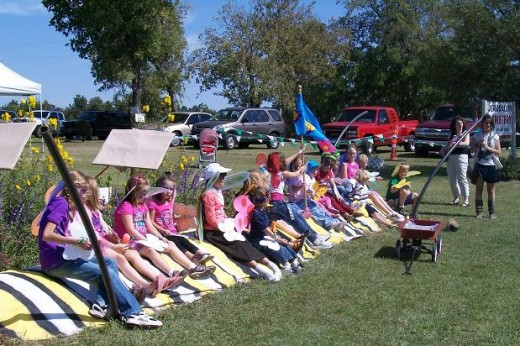
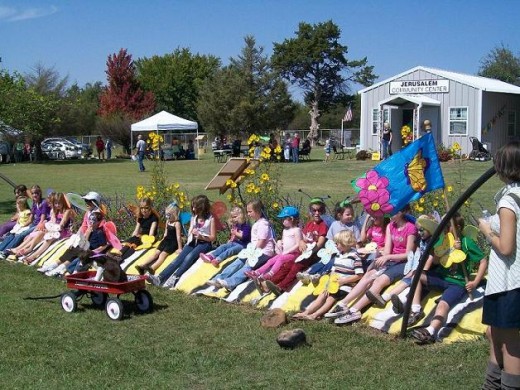
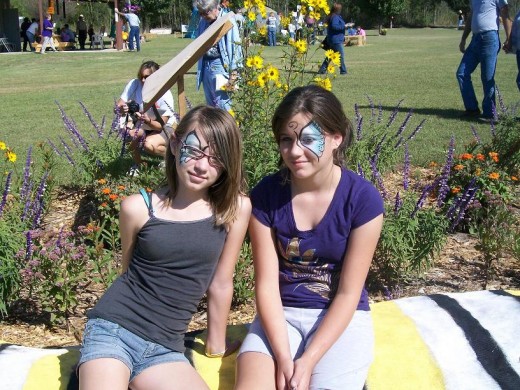
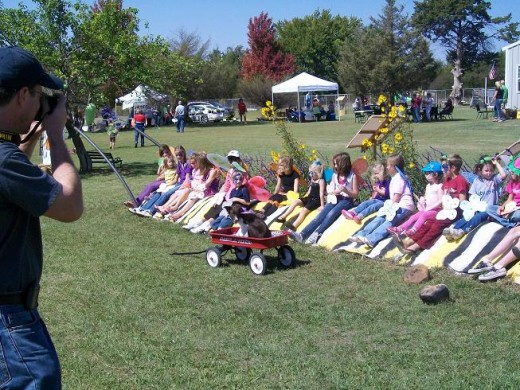
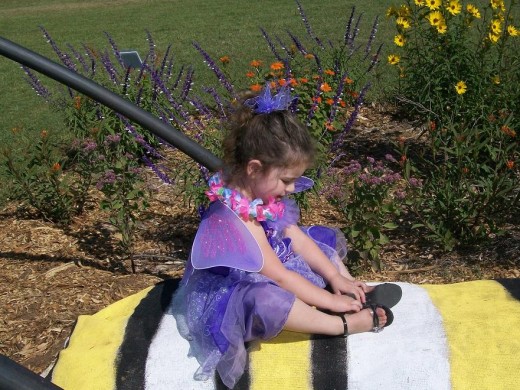
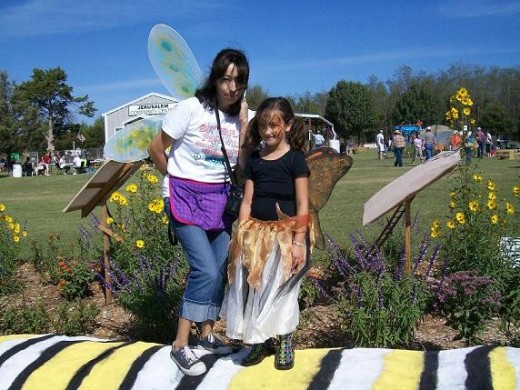
Celebrations have facets, and freedom is one...
This year’s event attendance was likely somewhat decreased by the occurrence of two other ‘festivals’ on this same day: The nearby OU/TX football game, and the Yukon Czech Festival. However, the approximately five-hundred plus number of those attending the Monarch Migration Celebration is not nearly important perhaps, as the fact that the gregarious and companionable attendees chose to share their pleasurable activities together, and in honor of a tiny beautiful creature – the instinctively brave, fragile, determined, helpless, distinctive Monarch Butterfly: May they ever return!
Another poignant facet of the Jerusalem Community Monarch Celebration 2010 was the small cemetery alongside the Festival grounds. There are partial views of that area in several of the pictures shown. The well-kept fenced memorial park has a huge ancient juniper-type tree near the entrance. Its gigantic scarred trunk is worn with the struggle of years and storms and its high-reaching limbs are still hovering over the gravesides of veterans buried there among friends and family. A granite memorial list of veterans whose lives were sacrificed-- and many of those in the Mid-east wars -- stands close to the entry gate under the archaic juniper, and several of the deceased heroes bore the same last names. It was a captivating response to note the commemorative stone and the several honored names engraved.
It is fitting to remember that the celebration of families and friends today was freely accomplished because of those very heroes who now rest near that stalwart juniper, and their memory should receive admiration, respect and reverence --our gratitude-- from we who may still live in the freedom they purchased with their sacrifice! May God bless the good in America, the many families of those who died, and those now who still work to preserve it.
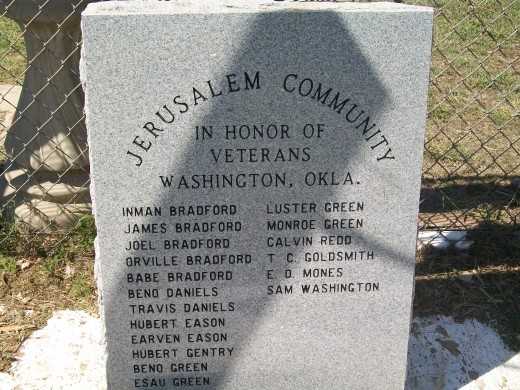
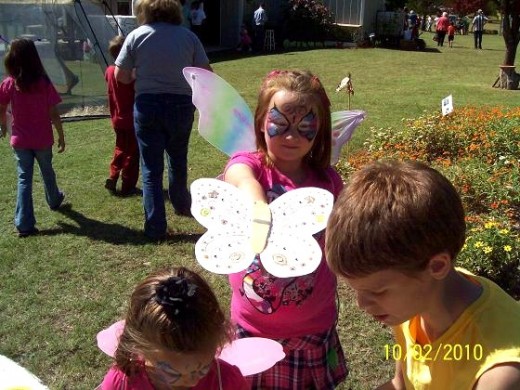
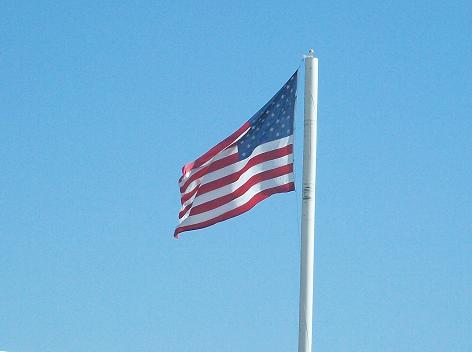
Another facet, another tree.
An elm sapling stands decorated with paper lanterns as symbols of bright hope, and fluttering butterfly decorations in its branches. It grows in the southern front lawn of these historic acres, tended well through the hot dry summers. It is a sapling grown from the Survivor Tree seeds at the Oklahoma City Murrah Memorial Site, (Oklahoma City National Memorial) donated to the historic Jerusalem Community.
The reproduction of that memorable Survivor Tree, in the hundreds now, is a symbol of a people free to seek happiness, and freedom to defend that right. It is a symbol of ‘natural courage', the unseen healing processes of Nature that we may not fully understand, but seen in the magnificence of the Survivor Tree now as compared to when it was nearly destroyed.
Yes, it required the help of authoritative knowledgeable helpers, too. There are pictures of that same lone tree in the earliest pioneer days of Oklahoma City, a young sturdy elm where wagons and horses found shade as the history of our city birthed. (Note: Pictures are archived at the Oklahoma Historical Museum of that young elm in the dirt streets of Oklahoma City.)
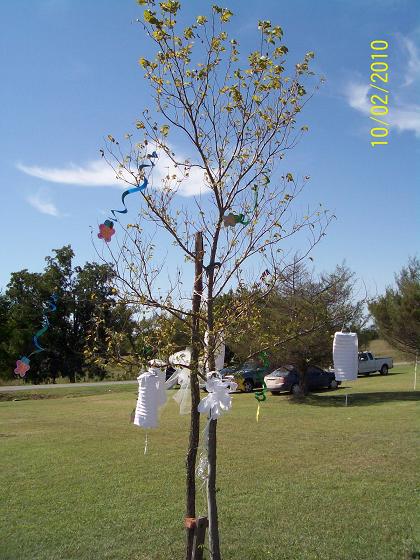
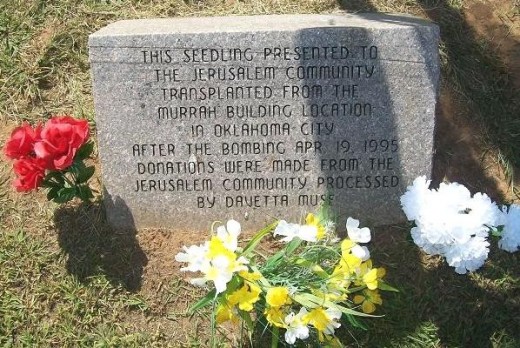
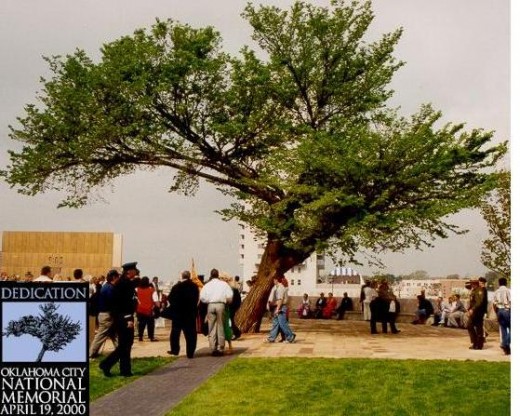
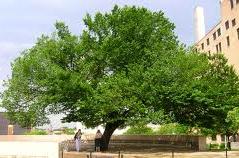
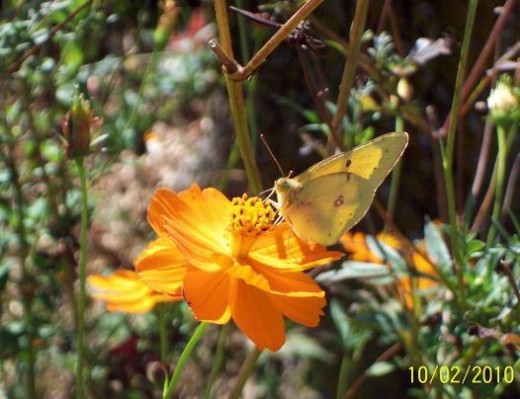

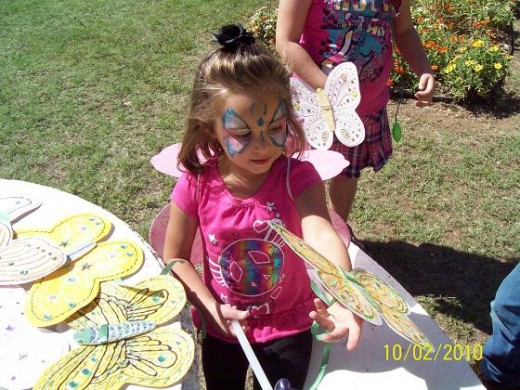
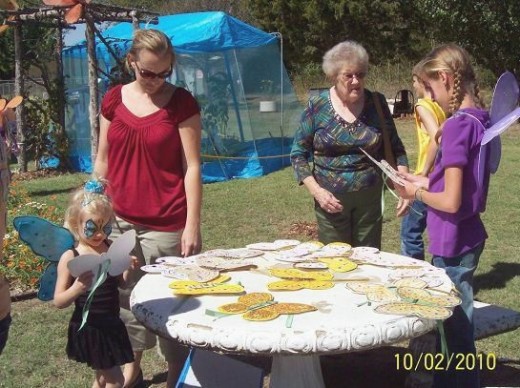
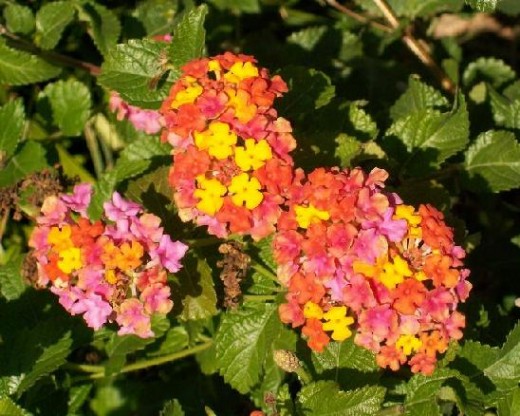
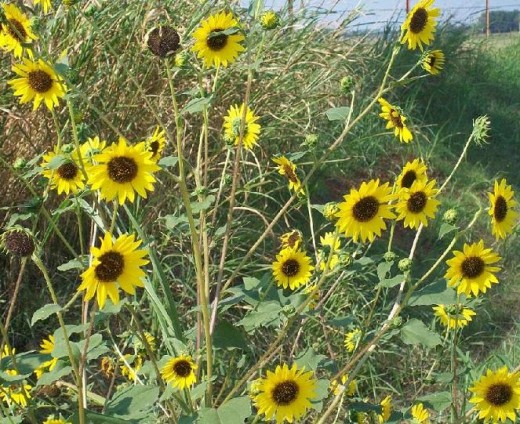
As we have celebrated today and look to the future, the hope for good peoples is to garner courage in facing the troublesome facets of our personal worlds, our world: To seek assisting and protecting the prospects of our children and all worthy helpless; then in so doing find simple fulfillment that brings ‘companionship of home-folk’ to the heart of every one.
And may we ever enjoy the meandering company of butterflies, soaring admirably down the fragile pathways of centuries old freedom.
Anyone interested may be involved in ongoing research activities.
The study and research of butterflies is a science to which any interested amateur can contribute. The simple knowledge required and the amount of time invested may be minimal, or could become a shared fulfillment of excitement that gains from long term involvement.
Any who wish further information regarding Monarch Support assistance, planting host/nectar gardens, delving into volunteer projects as needed, or to grant a donation of funds, may contact Annie Hart at P.O. Box 671, Blanchard, Ok 73010. Generally a SASE or LSASE is requested, depending on the materials you want.
Links: These links are offered for you to explore, to involve yourself and others in learning, and perhaps assisting in this ongoing rejuvenating project.
www.livemonarch.com free milkweed seeds
www.monarchwatch.com official tagging program information
www.wildthingsnursery.com native OK plants for butterflies
www.thebutterflysite.com lists of nectar and host plants
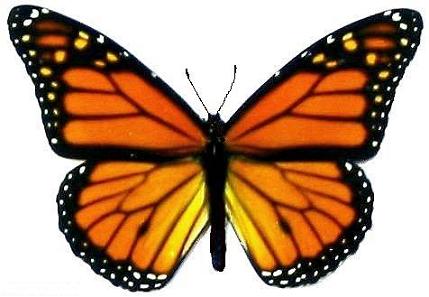
Hubpages links to butterfly articles of interest.
- Everything you need to know about Butterflies
Interesting facts and information about butterflies - Butterflies of Oklahoma-15 Beautiful Specimens And How To Attract Them
The Sooner State is home to a wide variety of butterflies. Here are fifteen of the prettiest Oklahoma butterflies, along with suggestions for butterfly gardens, butterfly puddles, and butterfly lore. - The Monarch Butterfly
From underneath the leaf of a milkweed plant, A new life is born, at first so scant. Its egg is no larger than the head of a pin. What a huge world for a tiny life to begin. The larva sheds... - Monarch Butterfly Migration
Millions of Monarch Butterflies migrate from Mexico to North America every spring. The journey begins in Mid March and ends in June. The Monarchs spend the winter months feeding in Mexico before taking off... - How To Attract Monarch Butterflies
Monarch butterflies are one of the world's most beautiful and beloved insects, but in recent years they have come under threat from pesticides and habitat destruction in both their summer homes in the United... - Monarch Butterflies, Raising the Insect from Scratch
The Poisonous Caterpillar showing Warning Coloration munching on Milkweed. The beautiful, gilded Chrysalis fit for a King Monarch Butterfly feeding on nectar from an Aster in Canada A flock of Adult Monarchs...
